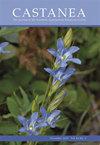晨间蝴蝶游客对夜花Hawkmost授粉植物有益吗?
IF 0.3
4区 生物学
Q4 PLANT SCIENCES
引用次数: 1
摘要
摘要:粗糙的鹅绒种子,茜草科的粗叶鞘花,白色,管状,芳香,晚上开放,是山楂科的常客。花朵持续一天,最近的观察表明,蝴蝶也会造访这些花朵。鹰蛾在花朵上方盘旋,将长鼻伸进花冠中采集花蜜。蝴蝶在插入长鼻之前降落在花瓣上,可能会在身体和口器上运输花粉。我们进行了一项实验,以确定这些群体中的每一个对结痂G.scabra授粉的重要性。我们排除了一些花序的白天访客和同一植物上其他花序的夜间访客(有两个对照:一些一直开放,一些一直装袋)。我们在选定花序的整个开花期内维持了这一方案两个多月,并比较了不同处理的坐果情况。对照开放花序和夜间开放花序的坐果显著高于日间开放花序和对照套袋花序。日间开放加夜间开放的花序的平均坐果与对照开放的花序接近,尽管日间开放的花的坐果较小,但与袋装对照不同。结痂的坐果几乎完全由山楂决定,但蝴蝶可能是有用的二次传粉昆虫。由于植物在下午和晚上的降雨可以持续到晚上的月份开花,因此早上的传粉者可能很重要。这项研究提供了额外的证据,证明昼夜授粉者可以帮助以夜间授粉为主的植物繁殖。本文章由计算机程序翻译,如有差异,请以英文原文为准。
Do Morning Butterfly Visitors Benefit a Night-Flowering Hawkmoth Pollinated Plant?
ABSTRACT The white, tubular, fragrant flowers of Guettarda scabra (Rubiaceae), rough-leaved velvetseed, open in the evening and are visited by hawkmoths (Sphingidae). Flowers last for one day, and recent observations reveal that butterflies also visit these flowers. Hawkmoths hover over the flower and lower their proboscis into the corolla to collect the nectar. Butterflies land on the petals before inserting their proboscis and may transport pollen on their bodies as well as their mouthparts. We conducted an experiment to determine the importance of each of these guilds for pollination of G. scabra. We excluded day-time visitors from some inflorescences and night-time visitors from others on the same plants (with two controls: some open all the time and some bagged all the time). We maintained this regimen during the entire flowering period of the selected inflorescences over two months and compared fruit set among the treatments. The control-open inflorescences and the night-open inflorescences had substantially higher fruit set than day-open and control-bagged inflorescences. Mean fruit set of day-open plus night-open inflorescences approximated that of control-open inflorescences, and although the fruit set of day-open flowers was small, it differed from bagged controls. Fruit set in G. scabra is determined almost entirely by hawkmoths, but butterflies may be useful as secondary pollinators. As plants flower in months when afternoon and evening rains can extend into the night, morning pollinators may be important. This study provides additional evidence that diurnal pollinators can contribute to the reproduction of predominantly nocturnal pollinated plants.
求助全文
通过发布文献求助,成功后即可免费获取论文全文。
去求助
来源期刊

Castanea
生物-植物科学
CiteScore
0.50
自引率
25.00%
发文量
28
审稿时长
>12 weeks
期刊介绍:
Castanea is named in honor of the American Chestnut tree. Castanea is thebotanical name for Chestnuts, dating back to what the ancient Greeks calledthem.
The American Chestnut is a critically endangered tree that once made up 35%of the forests of the Eastern US before being devastated by a blight thatdestroyed up to 4 billion American Chestnut trees.
Castanea serves professional and amateur botanists by reviewing andpublishing scientific papers related to botany in the Eastern United States.
We accept papers relating to plant biology, biochemistry, ecology, floristics,physiology and systematics.
 求助内容:
求助内容: 应助结果提醒方式:
应助结果提醒方式:


